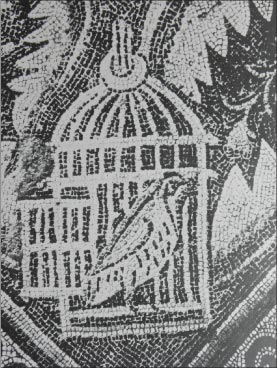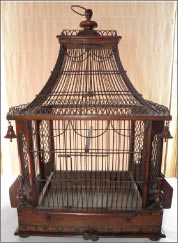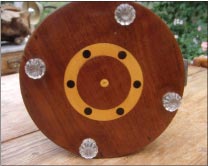BIRD-CAGES – A FASCINATION
If it hadn’t been for my uncle who gave me my first birdcage with a real living bird inside, I don’t think I would have developed the fascination for collecting them, with or without birds inside.
In February 1966, my uncle, the actor Stewart Granger, offered to give me a Lesser Sulphur-crested Cockatoo in a modern but huge and beautiful white-painted metal cage topped with a gilded knob. Jimmy, for that was what everyone called him, had given it to his Belgian wife Caroline, known by the family as the ‘Brussels Sprout’, for Christmas 1965.
‘Snowy’ (already named by the pet shop) the Cockatoo must have been a male because it fell madly in love with Caroline and instantly disliked Jimmy! So much so that two months later Jimmy issued an ultimatum – either the Cockatoo must go or he would. Luckily for the marriage Caroline chose to keep Jimmy and I was duly given Snowy.
In 1965 my mother had come to live at Hovis Mill, on the Colne, which she renamed ‘Maplestead Mill’, although since her death the name has reverted back to ‘Hovis’.
The arrival of the cockatoo at the Mill was an excitement and a novelty and I spent hours getting to know Snowy. My uncle had bought him from the pet shop in Gloucester Road, but no-one knew whether he was male or female, or indeed how old he was, and as they can live for over 100 years, he could still be alive today.
Parrot keepers will recognize that these birds tend to relate to one person at a time, and the adoration for the ‘Brussels Sprout’ transferred itself to me! So when I got my first job at Sotheby’s in September 1966, Snowy was left all week at the Mill with my mother. Apparently, he screamed incessantly from the moment I left until I returned, attacking and pecking my mother if she dared to approach him.
Snowy plus cage were given to an old couple in Colne Engaine!
Twelve years later, after my mother had died and my two sons were 3 and 4, I took them to the couple’s house to meet Snowy, and as I entered the couple’s living room it was obvious that Snowy had been given the freedom of the house for, having recognised my voice, he landed on my shoulder with a screech of delight and began pecking my cheek. Like elephants, parrots never forget!
Needless to say my sons begged me to get Snowy back, but he had obviously become the equivalent of the couple’s dog or child and it would have broken their hearts to lose him. The next time we went in search of Snowy the couple had either moved or died, and to this day we long to find him again.
This article was supposed to be all about birdcages but Snowy took over, just like he did at the Mill so long ago!
When I joined Sotheby’s Furniture Department, their catalogues only included pre-1830s furniture, Victorian furniture being considered too modern. As a result I became, and still am, fascinated in and a great admirer of Georgian and earlier furniture, in particular bird-cages and their place in our domestic history.
In researching for this article I was amazed to learn that caged birds were man’s first true pets. Although the dog and the cat predate the cage bird as companions, these were originally kept for hunting and vermin control respectively.
Keeping trained or tamed birds in cages was a hobby restricted to aristocratic and royal families, and pre-dated the keeping of birds for food as early as 1500BC. The stunning colours of their plumage and the beauty of their song played major roles in the choice of bird.
Fig. (1) Shows a Byzantine tile, circa AD300, with a quail in a bird-cage. These charming little creatures were an early favourite, with their pretty plumage, although I don’t think their song is particularly melodious!
Aristocratic families in Rome were known to have kept caged magpies in their porches as guards and, because these birds were good mimics, barbers had them to entertain their customers. Ravens, too, were thought to have been caged for the same purpose.

Fig.1
African parrots became the new treasured pets of the Romans and, later, with the opening of the trade routes, it was the Portuguese who brought over the nominate race of canary (Cerinus c. canarius) from Madeira, Canary Islands and the Azores.
Germany’s Harz mountain area became famous for some of the earliest bird-cages which were carved to emulate chalets, in the same style of the cuckoo-clock cases. These early cages contained tiny internal doors which could be opened or shut to control the bird’s song, and to enable the occupant to roost in darkness and to awake at dawn.
East Anglia, in particular the area around Norwich, became famous in the 18th century for canary-breeding by the Huguenot refugees from the Low Countries.
The discovery of the ‘New World’ and its enormous range of exotic birds added to the noblemens’ colourful aviaries.

Fig. 2.
Charles II became a bird fancier, following his grandfather, James I, who had established a wildfowl collection in St. James’s Park. It was Charles who gave orders to line the adjoining street with all manner of caged birds, a street which, in 1691, became known as ‘Birdcage Walk’.
Canaries kept by Dutch burghers in the 17th century became a symbol of trading wealth, their cages showpieces of precious materials such as ebony, ivory and blown glass, with porcelain feeding vessels. The period between 1750 and 1850 was the most innovative in birdcage design.
The first half of the 18th century saw garden aviaries as important additions to formal layouts and, by the second half, fancy pheasants from China heralded the fashion of all things ‘chinoiserie’. Chippendale furniture exemplified the new craze. Fig. (2) A George III ‘chinoiserie’ birdcage with parquetry detail. To prevent seeds splattering over the floor a sliding tray in the base pulls out like a drawer which helps the cleaning of the cage.
The ‘Gothic’ style followed the Chinese influence, although these continued in parallel and indeed some
bird-cages incorporated both: Fig. (3) A French circa 1770 cast-iron bird-cage, said to have come from a monastery in the South of France.

Fig. 3.
By the 19th century, bird-cages were made in all manner of material. One of my favourites is shown in Figs. 4 and 5, a c.1820 rare travelling bird-cage together with its fitted case. Note the parquetry inlay not just on the surround but underneath, for hanging or standing on its four cut-glass feet. The fitted box is lined with handblocked printed paper. This case would not permit a poor little linnet to breathe for very long, so its visual attractiveness would appear to exceed its practicality.

Fig. 4.

Fig. 5.
During the 1830s the Swiss perfected singing bird ‘automata’ in gilt-metal cages, which could move and sing realistically, with clockwork winding levers, and bellows inside. The birds themselves would have real and colourful feathers.

Fig. 6. A Regency painted wood

Wirework bird-cage of architectural form inset with a timepiece.
Fig. 7.
By 1840, Edmund Perry and Henry Fearncombe had perfected a wire-drawing technique that spun a metal cage dome in a single operation, see Fig. (7) A modern Dutch example of this technique.
Fig. (8) This is a French blue-painted wirework bird-cage c.1880, as is Fig. (9) which is gilded and painted pink in ‘chinoiserie’ form.
Victorian bird-keeping was most popular in the 1860s, when it was estimated that at least 4,000 canary breeders in Norwich alone were engaged in supplying birds for the London markets. Apart from canaries and budgerigars, native goldfinches, cock linnets and siskins were also in demand.

Fig. 8.

Fig. 9.
All manner of shapes and sizes, materials and colours can be found today, although the cheaper cages are manufactured in the Far East, ‘aged’ to look old and exported to Europe to be sold as ‘antiques’. Be careful!
Bunny Grahame
Bunny Grahame, a.k.a. Bunny Campione, was at Sotheby’s for 30 years. After the Furniture Dept., she opened their Doll and Automata Dept. in 1981 and still holds the world auction record of £188,000 for an antique doll. She held the first auction for Teddy Bears in 1983 and, in 1988, while remaining as a Consultant, she started her own company Campione Fine Art, specialising in buying and selling antiques for clients. In 1987 she joined the BBC’s Antiques Roadshow valuing items under the ‘Miscellaneous’ category. She lives at Daws Hall with her husband, the antiquarian book dealer Iain Grahame, who started the Daws Hall Nature Reserve and Environmental Education Centre in 1985.
